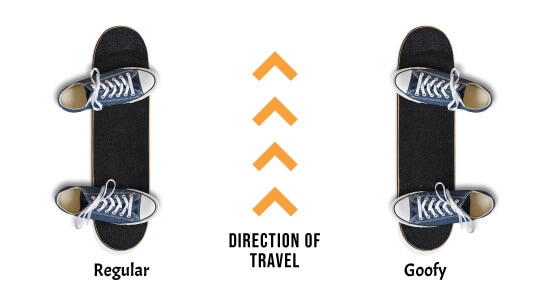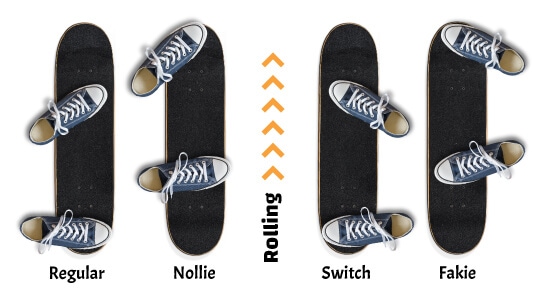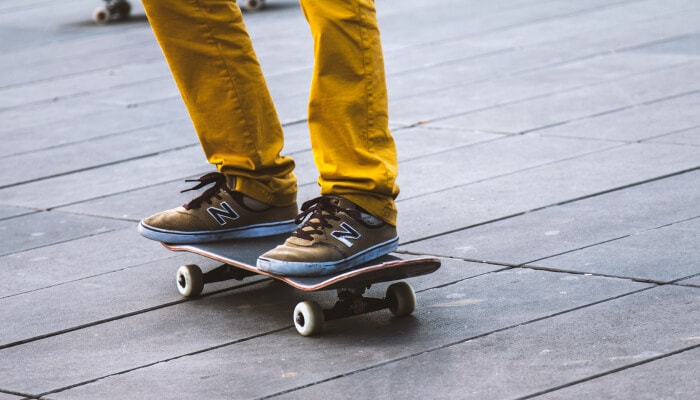Skateboarding reminds us of ideas of speed, tricks, and an excitement unmatched by many other activities. It’s a sport that balances dexterity, coordination, and unadulterated artistic expression. Standing on a skateboard is essential to this thrilling universe’s heart.
Your stance is more than just style; it’s the foundation of a comfortable ride, the key to gaining control, and the formula for stability as you perform mind-blowing skating tricks.
We will take you on a journey through this extensive manual to teach you the skill of standing on a skateboard. We’ll review the various positions, explain the differences, and show you how to adopt them successfully. This manual is your go-to companion whether you’re a beginner getting on your first deck or an experienced skateboarder trying to polish your tricks.
Regular Vs. Goofy: Finding Your Natural Stance

Understanding your natural stance is the first step in standing on a skateboard. There are two main stances: regular and goofy.
Regular-footed skateboarders lead with their left foot forward, pushing off with their right foot. Conversely, goofy-footed skaters lead with their right foot and push off with their left foot. Neither stance is superior, and the choice between regular and goofy comes down to personal preference and comfort.
Determining your natural stance is simple. A standard method is to have someone gently push you from behind. The foot you instinctively step forward with is your leading foot.
Decoding the Four Skateboard Stances

The Natural Skateboard Stance
The natural stance is your inaugural position when stepping onto a skateboard. For regular-footed skaters, the left foot gracefully claims its spot near the front of the skateboard, referred to as the “nose,” while the right foot finds its place near the rear, the “tail.” Conversely, this arrangement is reversed for those who embrace the goofy stance, with the right foot leading at the nose and the left guarding the tail. It’s the foundational stance that kickstarts your journey on the skateboard.
The Nollie Skateboard Stance
The nollie stance takes the natural stance and adds a dash of flair. In this variation, both feet shift towards the nose of the skateboard. This tweak isn’t for mere aesthetics; it’s the essential precursor to executing a nollie, a trick that involves popping the skateboard’s nose off the ground with finesse. It’s a move that signifies your growing prowess on the board, offering a sneak peek into the world of tricks and style.
The Switch Skateboard Stance
Now, let’s switch things up – quite literally! The switch stance challenges you to ride your skateboard in the opposite direction of your natural stance. For those who confidently roll in a regular stance, this means embracing the goofy stance and vice versa. It’s a skill that demands dedication and practice but unlocks the door to a realm of advanced tricks and maneuvers. Mastering the switch stance is akin to becoming bilingual in the language of skateboarding; it broadens your horizons and lends versatility to your skating repertoire.
The Fakie Skateboard Stance
Lastly, the fakie stance spices things up by mixing your natural stance with a dash of reverse motion. Picture yourself moving backward while your feet remain steadfast in regular or goofy positions. This unique stance often emerges due to certain tricks, like the classic 180-degree turn. Riding fakie might initially feel counterintuitive, but with practice, it becomes a signature move in your bag of skateboarding tricks, adding a twist to your style.
Discovering Your Distinctive Style
Every skateboarder possesses a one-of-a-kind style, and it’s essential to fully embrace and celebrate your own as you embark on the journey of learning to balance atop a skateboard. This process entails a delightful exploration of various foot placements, weight distributions, and body postures to unveil the configuration that resonates with you, providing the utmost comfort and a sense of natural flow. Remember, skateboarding serves as a canvas for self-expression, so never shy away from allowing your unique personality to illuminate your skating style.
The Adventure of Learning and Conquering Tricks
Once you’ve conquered the art of maintaining equilibrium on a skateboard, it’s time to dive headfirst into the exhilarating realm of learning and mastering tricks. Your journey commences with the basics, like ollies and kickflips, which are the building blocks for more intricate and awe-inspiring maneuvers. It’s a journey marked by triumphs and stumbles, where persistence is your most loyal companion.
However, safety should remain paramount as you embark on this thrilling ride. Prioritize your well-being by equipping yourself with the proper protective gear, ensuring you’re shielded against the occasional tumble. Also, choose your practice grounds carefully, selecting environments with a secure and supportive backdrop for your skateboarding exploits.
In essence, skateboarding is not merely a sport; it’s a form of artistic expression, a means to push the boundaries of what you thought was possible, and a celebration of your individuality. So, as you navigate your unique journey on wheels, remember to infuse your distinctive style into every trick and ride, creating a vibrant tapestry of movement that reflects your authentic self.
Conclusion
Learning to stand on a skateboard is the foundation of your skateboarding journey. By understanding the different stances and finding your natural footing, you’ll be well on your way to mastering this thrilling sport. Whether you’re a beginner or a seasoned pro, never stop exploring, learning, and pushing your boundaries. Skateboarding is a journey of continuous growth and self-discovery, so enjoy every moment of the ride.
